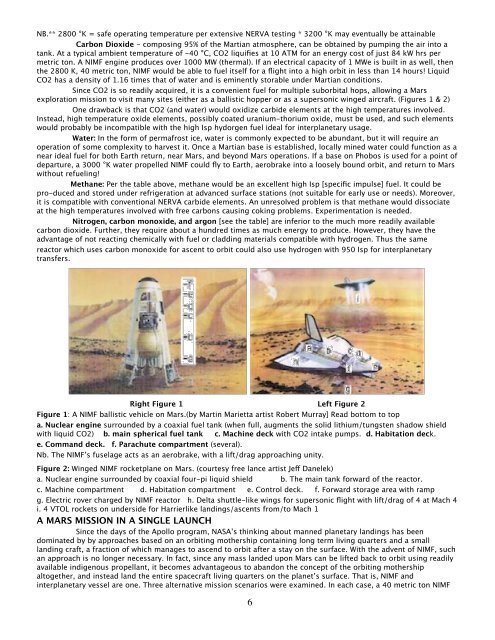Space Transportation - mmmt_transportation.pdf - Moon Society
Space Transportation - mmmt_transportation.pdf - Moon Society
Space Transportation - mmmt_transportation.pdf - Moon Society
You also want an ePaper? Increase the reach of your titles
YUMPU automatically turns print PDFs into web optimized ePapers that Google loves.
NB.** 2800 °K = safe operating temperature per extensive NERVA testing * 3200 °K may eventually be attainable<br />
Carbon Dioxide - composing 95% of the Martian atmosphere, can be obtained by pumping the air into a<br />
tank. At a typical ambient temperature of -40 °C, CO2 liquifies at 10 ATM for an energy cost of just 84 kW hrs per<br />
metric ton. A NIMF engine produces over 1000 MW (thermal). If an electrical capacity of 1 MWe is built in as well, then<br />
the 2800 K, 40 metric ton, NIMF would be able to fuel itself for a flight into a high orbit in less than 14 hours! Liquid<br />
CO2 has a density of 1.16 times that of water and is eminently storable under Martian conditions.<br />
Since CO2 is so readily acquired, it is a convenient fuel for multiple suborbital hops, allowing a Mars<br />
exploration mission to visit many sites (either as a ballistic hopper or as a supersonic winged aircraft. (Figures 1 & 2)<br />
One drawback is that CO2 (and water) would oxidize carbide elements at the high temperatures involved.<br />
Instead, high temperature oxide elements, possibly coated uranium-thorium oxide, must be used, and such elements<br />
would probably be incompatible with the high Isp hydorgen fuel ideal for interplanetary usage.<br />
Water: In the form of permafrost ice, water is commonly expected to be abundant, but it will require an<br />
operation of some complexity to harvest it. Once a Martian base is established, locally mined water could function as a<br />
near ideal fuel for both Earth return, near Mars, and beyond Mars operations. If a base on Phobos is used for a point of<br />
departure, a 3000 °K water propelled NIMF could fly to Earth, aerobrake into a loosely bound orbit, and return to Mars<br />
without refueling!<br />
Methane: Per the table above, methane would be an excellent high Isp [specific impulse] fuel. It could be<br />
pro-duced and stored under refrigeration at advanced surface stations (not suitable for early use or needs). Moreover,<br />
it is compatible with conventional NERVA carbide elements. An unresolved problem is that methane would dissociate<br />
at the high temperatures involved with free carbons causing coking problems. Experimentation is needed.<br />
Nitrogen, carbon monoxide, and argon [see the table] are inferior to the much more readily available<br />
carbon dioxide. Further, they require about a hundred times as much energy to produce. However, they have the<br />
advantage of not reacting chemically with fuel or cladding materials compatible with hydrogen. Thus the same<br />
reactor which uses carbon monoxide for ascent to orbit could also use hydrogen with 950 Isp for interplanetary<br />
transfers.<br />
Right Figure 1 Left Figure 2<br />
Figure 1: A NIMF ballistic vehicle on Mars.(by Martin Marietta artist Robert Murray] Read bottom to top<br />
a. Nuclear engine surrounded by a coaxial fuel tank (when full, augments the solid lithium/tungsten shadow shield<br />
with liquid CO2) b. main spherical fuel tank c. Machine deck with CO2 intake pumps. d. Habitation deck.<br />
e. Command deck. f. Parachute compartment (several).<br />
Nb. The NIMF’s fuselage acts as an aerobrake, with a lift/drag approaching unity.<br />
Figure 2: Winged NIMF rocketplane on Mars. (courtesy free lance artist Jeff Danelek)<br />
a. Nuclear engine surrounded by coaxial four-pi liquid shield b. The main tank forward of the reactor.<br />
c. Machine compartment d. Habitation compartment e. Control deck. f. Forward storage area with ramp<br />
g. Electric rover charged by NIMF reactor h. Delta shuttle-like wings for supersonic flight with lift/drag of 4 at Mach 4<br />
i. 4 VTOL rockets on underside for Harrierlike landings/ascents from/to Mach 1<br />
A MARS MISSION IN A SINGLE LAUNCH<br />
Since the days of the Apollo program, NASA’s thinking about manned planetary landings has been<br />
dominated by by approaches based on an orbiting mothership containing long term living quarters and a small<br />
landing craft, a fraction of which manages to ascend to orbit after a stay on the surface. With the advent of NIMF, such<br />
an approach is no longer necessary. In fact, since any mass landed upon Mars can be lifted back to orbit using readily<br />
available indigenous propellant, it becomes advantageous to abandon the concept of the orbiting mothership<br />
altogether, and instead land the entire spacecraft living quarters on the planet’s surface. That is, NIMF and<br />
interplanetary vessel are one. Three alternative mission scenarios were examined. In each case, a 40 metric ton NIMF<br />
6















